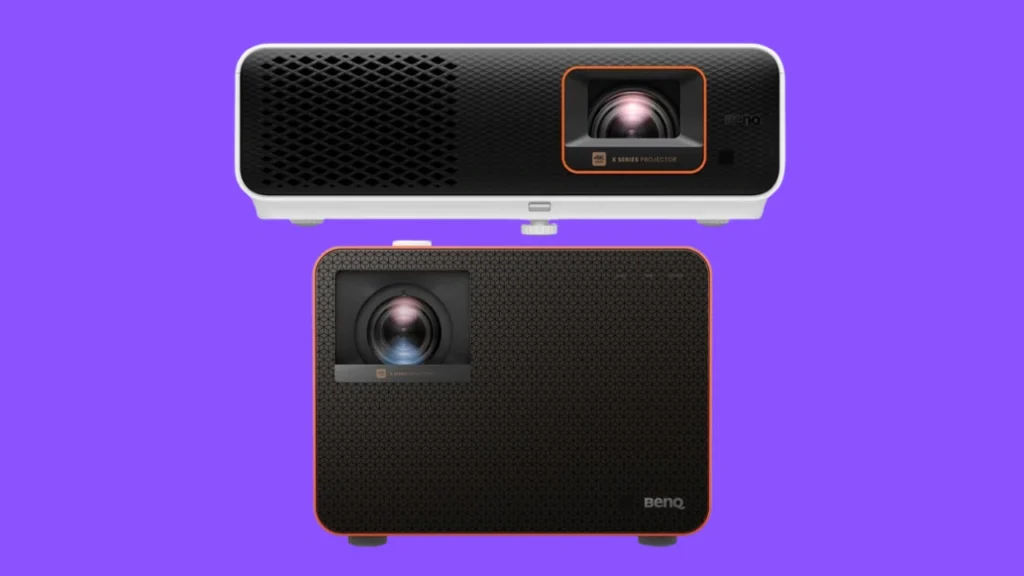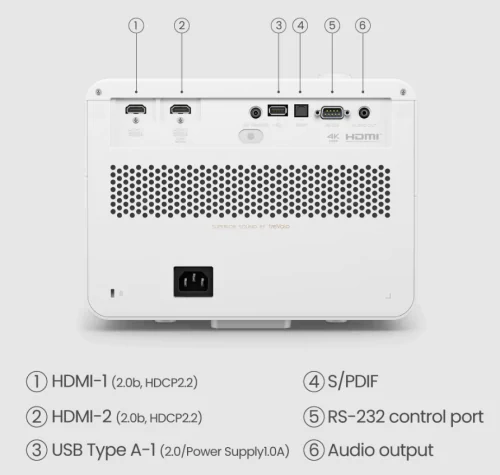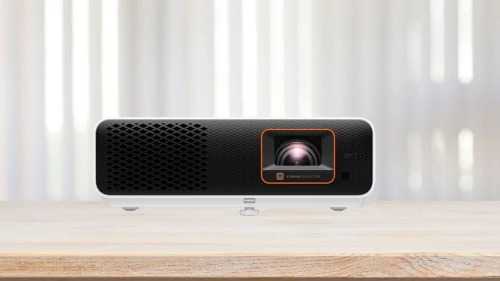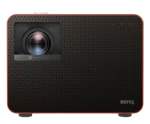Today we’re comparing two of BenQ’s latest gaming projectors: the X500i and the X3100i. Both are marketed as gaming-focused models and launched around the same time, but there’s a big catch—a $700 price gap between them. With similar release windows and gaming ambitions, the real question is: does the X3100i justify its much steeper price, or does the X500i deliver better value for most people? Let’s break it down.

In This Comparison:
BenQ X500i vs. X3100i: Specifications
Take a moment to look over the spec table above—there’s a lot to unpack. On paper, the X500i and X3100i share several core features: both offer 10-bit color processing, identical dynamic contrast at 600,000:1, and the same ultra-low input lag across resolutions. But some key differences stand out. The X3100i boasts significantly higher brightness at 3,300 lumens versus the X500i’s 2,200, has a slightly greater zoom range, and includes vertical lens shift for easier setup flexibility. On the flip side, the X500i’s biggest edge is its much shorter throw distance, making it ideal for small rooms or tight setups. Specs give us the outline—but the real story is in how these projectors perform in actual use. Let’s get into it.
Image Quality

We started our testing by focusing on image quality, evaluating both the X500i and X3100i in dark and daylight conditions. The most immediate difference was brightness. The X3100i’s 3,300 lumens gave it a clear edge in well-lit environments, delivering a more watchable and punchy image during the day. The X500i, while still solid in dim lighting, struggled more under direct daylight, where darker scenes lost detail.
Resolution is identical across both models—true 4K (3840×2160)—and both use the same DLP chip type with 10-bit color processing. Contrast performance felt comparable too, consistent with their shared 600,000:1 dynamic contrast ratio. In a dark room, both units delivered strong blacks and vivid highlights, with the X3100i’s higher brightness adding a bit more pop to HDR content.

Throw distance was where the X500i stood out. It’s a short-throw projector, needing just about 5 to 6 feet for a 100-inch image. The X3100i, in contrast, required over 8 feet for the same screen size. That makes the X500i far more flexible in smaller spaces. Overall, the X3100i pulled ahead in raw image performance, but the X500i held its own surprisingly well—especially considering the price gap.
Winner: BenQ X3100i
Gaming and Sound

For gaming, we tested both projectors across multiple consoles—PS5, Xbox Series X, and Nintendo Switch—focusing on fast-paced shooters and racing games. Input lag was nearly identical, with both models delivering smooth, responsive gameplay. Whether we were running at 4K/60 or pushing 1080p at 120Hz, we didn’t notice a meaningful difference in responsiveness. Both projectors also automatically detected the consoles and switched into their game-optimized modes without issue.
Visually, the gaming experience was equally solid on both. The X3100i’s extra brightness gave a slight edge in clarity under ambient light, but in a darkened room, the differences mostly disappeared. The built-in FPS crosshair and SettingXchange profiles on both units were easy to use and helpful for dialing in game-specific settings.

When it came to audio, though, the X3100i did have an edge. Both projectors include dual 5W speakers, but the X3100i features BenQ’s CinematicSound with Bongiovi DPS. In testing, this gave it slightly fuller sound with more depth and clarity—enough to notice, especially in dialogue-heavy games. Still, for serious gaming sessions, we’d recommend using an external audio setup with either projector.
Winner: a Tie
Smart Features

We also spent time testing the smart features on both models, and the experience was mostly identical. Both projectors run Android TV, are Google-licensed, and come with built-in access to streaming apps like YouTube, Netflix, and Prime Video. Navigation felt smooth on both units, and app loading times were quick and reliable.
Google Assistant voice control worked the same across both, and casting content from Android devices was seamless. We also tried sideloading a few apps, and the process was straightforward on both projectors. No surprises there—they’re functionally equal when it comes to streaming and smart TV use.

One small difference: the X3100i has slightly snappier performance when switching between apps or multitasking. It’s subtle, but noticeable if you’re doing a lot of browsing or hopping between streaming and gaming. Still, for most users, the smart platform experience will feel virtually the same on both projectors.
Winner: a Tie
OVERVIEWS:
BenQ X500i
 The BenQ X500i is a short-throw 4K gaming projector designed for smaller spaces and budget-conscious buyers. With 2,200 ANSI lumens and a sharp 600,000:1 dynamic contrast ratio, it delivers solid image quality in darker environments. Its standout feature is the short throw distance, making it ideal for compact rooms where space is limited. Thanks to low input lag and console auto-detection, gaming feels responsive and easy to set up. While it handles dark-room gaming and streaming very well, it falls behind slightly in bright-room performance compared to higher-end models.
The BenQ X500i is a short-throw 4K gaming projector designed for smaller spaces and budget-conscious buyers. With 2,200 ANSI lumens and a sharp 600,000:1 dynamic contrast ratio, it delivers solid image quality in darker environments. Its standout feature is the short throw distance, making it ideal for compact rooms where space is limited. Thanks to low input lag and console auto-detection, gaming feels responsive and easy to set up. While it handles dark-room gaming and streaming very well, it falls behind slightly in bright-room performance compared to higher-end models.
Pros
- True 4K resolution with sharp details
- Very low input lag across resolutions
- Short throw distance perfect for small rooms
- Google-certified Android TV built-in
Cons
- Struggles in bright, daylight-heavy rooms
- No lens shift for flexible placement
BenQ X3100i
 The BenQ X3100i aims higher, offering premium brightness at 3,300 ANSI lumens, slightly better zoom flexibility, and vertical lens shift for easier positioning. It maintains the same gaming advantages as the X500i—ultra-low input lag, automatic game mode detection, and console optimization—but brings a brighter, more vivid image to the table. Its improved audio with Bongiovi DPS also stands out, delivering richer sound without needing immediate external speakers. However, the much higher price tag and larger throw distance mean it’s less suited for small rooms unless you have the space to work with.
The BenQ X3100i aims higher, offering premium brightness at 3,300 ANSI lumens, slightly better zoom flexibility, and vertical lens shift for easier positioning. It maintains the same gaming advantages as the X500i—ultra-low input lag, automatic game mode detection, and console optimization—but brings a brighter, more vivid image to the table. Its improved audio with Bongiovi DPS also stands out, delivering richer sound without needing immediate external speakers. However, the much higher price tag and larger throw distance mean it’s less suited for small rooms unless you have the space to work with.
Pros
- Very bright image (3,300 ANSI lumens)
- Vertical lens shift for easier installation
- Better built-in audio with Bongiovi DPS
- Full HD 3D support
- Low input lag with console auto-detection
Cons
- High price compared to X500i
- Requires more throw distance (not ideal for tight spaces)
Conclusion
After spending time with both projectors, it’s clear that the X3100i is the more capable device overall. >>>Find the best current deal on Amazon. It offers higher brightness, a larger zoom range, vertical lens shift, and slightly better onboard audio. If you’re looking for a more versatile home theater projector that can handle bright rooms and flexible setups, the X3100i delivers.
But if your main focus is gaming, that $700 price difference becomes hard to justify. Both projectors offer virtually the same gaming experience—identical input lag, image quality in darker settings, and console-friendly features. The X500i even has the edge in short-throw setups, making it the smarter pick for smaller rooms.
Unless you need the extra brightness or installation flexibility, the X500i offers better value.>>>> Check the current price now You’ll get nearly the same performance where it counts for gaming, at a significantly lower cost.

